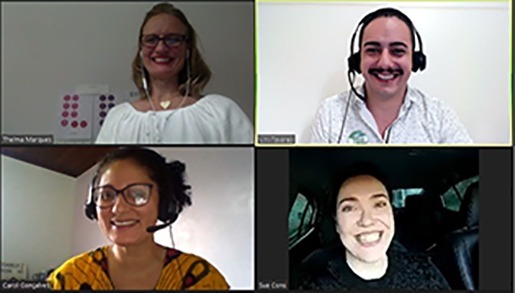There are many reasons to join a global or regional community of English language teaching professionals. Membership to the International Association of Teachers of English as a Foreign Language (IATEFL) or TESOL International Association (commonly referred to as TESOL) includes discounted access to exclusive conferences, webinars, and publications, but most of all, a community of fellow ELT educators.
Larger organizations like IATEFL and TESOL may have a global reach upwards of 4,000 members, however, and especially for a “newbie,” it’s all too easy to get swallowed up by the numbers and never make any meaningful connections with other teachers. Enter special interest groups, also known as ELT SIGs.
The Value of a Special Interest Group
Special interest groups exist in the English Language Teaching (ELT) industry because English language teachers are not a monolithic group of individuals. Teachers from all over the world are bound to have unique interests and different perspectives related to their teaching. A novice teacher serving business-oriented students may find support in a Business English tailored SIG, while a teacher preparing future ambassadors will look to an international diplomacy SIG for engaging materials.
A special interest group is just what it sounds like: a group of people in the same industry with a shared, but unique, interest that advances that specific area of knowledge. They are usually sub-organizations of a much larger association, like the IATEFL or TESOL, or KoTESOL (KoreaTESOL). Take a look at IATEFL’s 16 SIGs for an example.
Judith Mader, the SIG representative on the IATEFL board of trustees, explains the operations of a SIG from her point of view.
“SIGs do not have an independent existence from IAFTEFL,” Mader says. “But the one thing which I try to emphasize is that IATEFL SIGs are a totally integral part of IATEFL and not separate entities at all. That’s important as it is something which is often misunderstood!”
In the ELT industry, there are a collection of SIGs that specialize in everything from teaching young learners to using English for specific purposes, such as test preparation or learning technology. On the surface, some SIGs appear too niche, such as a dedicated SIG focused on pronunciation, but in reality, SIGS are the thought leaders of the ELT industry, promoting expertise and solutions on their relative topic.
In 2015, Joceyln Wright founded the Social Justice SIG (SJSIG) at KoTESOL. While she currently acts in a supportive role for the group, (versus a leading role) she recalls her motivation for activating SJSIG.
“Before SJSIG, KoTESOL had a few SIGS, including a Reflective Practice SIG,” Wright says. “But no group was really talking openly about critical issues. I felt a platform for exchange around diverse issues was necessary for the growth of individual teachers as well as the organization.”
The kick-off of SJISG at KoTESOL was the catalyst for other groups focusing on social advocacy in English teaching to enter the space. Since then, special interest groups at KoTESOL have expanded to include the Environmental Justice SIG, Women and Gender Equality SIG, and the People of Color Teachers’ SIG.
If the purpose of a SIG could be summed up in a few sentences, then truthfully, the function of a SIG, regardless of the parent organization, is to carry out the missions of the parent organization but with a much tailored subject matter.
SIGs support teachers’ development with programs and activities, they promote published studies for English teaching, they provide expanded communities and networks for professional advancement, and lastly, SIGs invite their members to share their ideas for publication, allowing teachers to earn accolades in the field.
So why is joining a SIG a benefit to you, an English language teacher?
English Language Teachers Can Make a Huge Impact by “Collaborating” with SIGs
Before David Valente became the lead coordinator of the IATEFL Young Learners & Teenagers SIG (YLTSIG), he was employed at the British Council for ten years, and of course, before that, he was an English teacher eager to explore the globe through being an educator.
When Valente left the British Council in 2014, he knew he wanted to retain the global network of English teachers and experts he built over the past decade. After all, teaching young learners was his passion.
“I have a big interest in writing, editing, and publishing,” Valente says, “I saw an IATEFL ad looking for writers, specifically for the YLTSIG. Because my background is in YLELT [young learners ELT], and because I had an interest in writing, I then applied for that role.”
Valente contributed to YLTSIG, writing articles and blogs for three years, before finally joining the committee in 2017.

The speaker lineup for IATEFL’s YLT SIG Web Conference in 2020.
Valente’s experience is, in fact, how many committee SIG members are recruited to join and possibly run a SIG as a coordinator. Teachers who share their ideas with ELT SIGs, many of whom are are already members or subscribers (although this is not always the case), will, at a bare minimum, have their materials reviewed by the committee. But more often than not, the SIG will invite the teachers to “collaborate” or contribute to produce materials for publishing.
Carol Gonçalves, the Coordinator of BRAZ-TESOL Pronunciation SIG (PronSIG) explains it simply: “Teachers are invited to share what they’ve researched, learned, studied, or experienced… and the idea is that these articles could be available for the BRAZ-TESOL newsletter or our website… and other teachers would have access to that.”
“Building a platform and influence while developing academically and professionally can be a direct consequence of joining a SIG.”
In circumstances where the teachers and the SIG committee members form a professional relationship, those teachers may be asked to join the SIG as a committee member and to take a role in furthering the success of the SIG. Hugo Dart, the Communications Coordinator of the BRAZ-TESOL Intercultural Language Education SIG (ILESIG), concurs and encourages BRAZ-TESOL members to become “partners” with any SIG they choose.
“It is possible for any member of BRAZ-TESOL to become a member of this core group,” Dart says, referring to the committee of ILESIG. “We are always open to bringing in people to help contribute to the events that we organize, and absolutely, to write.”
The networking benefits of participating in a SIG can be more significant than merely joining to consume the resources provided. Taking a proactive role in developing projects (webinars, blog posts, or trainings, for example) for a SIG may open doors to collaborate with other “thought leaders” and experts in the space. As with any industry, proximity to experts and influencers presents pathways to more paid opportunities and larger platforms for the teachers who are actively pursuing this goal.
“Building a platform and influence while developing academically and professionally can be a direct consequence of joining a SIG,” Dart says. “That’s a huge part of it.”
Therein comes the question about how to reach these SIGs to become a collaborator, contributor, or partner. David Valente responded to an IATEFL ad but the initial outreach is much simpler.
Gonçalves, at BRAZ-TESOL’s PronSIG, shares the same attitude as Dart in that teachers should never be discouraged from sharing an idea with the SIG they want to contribute to. Although it can be intimidating to approach the leaders of the SIG, especially with the aim to take a role in leadership (big or small), it’s more important to be prepared with a compelling pitch for review.
Currently, she and her committee are brainstorming how to effectively give teachers a voice regarding concerns within the SIG that should be addressed and to submit a topic for further exploration. This could take the form of a portal with the sole purpose of being a place for teachers to submit their ideas for the committee’s approval. For now, though, the simplest way to submit an idea to a SIG is to email a proposal.
“I am always telling teachers to ‘send a proposal!’ says Gonçalves. “You have nothing to lose.”
Volunteering – Making It Worth the Reward, Time, and Energy
Teachers who are IATEFL members are required to join one of the organization’s 16 active SIGs (covered as part of their annual membership dues), but there is no obligation to join the committee of their SIG of choice – and that is across the board for all ELT organizations.
There are those teachers, mostly seasoned professionals, who voluntarily set aside personal time and energy to dedicate to a SIG, taking on an extracurricular role outside of their normal commitments. Most ELT SIGs enlist roles such as a lead coordinator, events coordinator, treasurer, secretary, and the like.
“The volunteers over the years love sharing their knowledge, experience, dedication, and love for the community, while in return, they take with them a sense of pride, growth, and teamwork by their unselfish involvement.”
The individuals in these roles are all volunteers, and yet they are responsible for making sure the SIG remains fresh, relevant, and credible, while under a strict budget. They are not monetarily compensated by the parent association for their efforts, although that does not mean the volunteers don’t reap the rewards.
“Being a volunteer for any organization requires a special type of personality – one that is not satisfied with just standing back with the crowd because they want to give as well as receive,” says Rob Howard, Joint Coordinator for IATEFL’s Business English SIG (BESIG). “The volunteers over the years love sharing their knowledge, experience, dedication, and love for the community, while in return, they take with them a sense of pride, growth, and teamwork by their unselfish involvement.”
That being said, many SIG volunteers happily take on this task because they believe in the advancement of the subject matter. Some teachers even create brand-new SIGs to raise awareness of a subject never-before discussed but in growing demand.
For example, Mirela Ramacciotti, started the BRAZ-TESOL Mind, Brain, and Education SIG (MBESIG) with a primary mission to “understand how our brain works [and] eliminate false information about the brain and learning.” MBESIG began in 2018 and has grown to reach an audience of 400 loyal contacts that are tracking the movement of MBESIG.
To say that creating a new SIG within an international ELT organization is easy would be too simple, but there are a number of new SIGs that have taken off in recent years because teachers pick up on recurring inadequacies in the field.
“…There are a lot of people making a lot of money because they are qualifying as professional coaches and offering much more to their students.”
In 2019, Marcela Harrisberger, a 20-year ELT educator, founded the Coaching in ELT SIG for BRAZ-TESOL, although she has been a BRAZ-TESOL member since 2000. She understood the risks. In Brazil “coaching“ is a term that’s been overused and abused by all industry professionals; Brazilians generally associate coaches as over-promising schemers with little to no qualifications. Nevertheless, her commitment to establishing a coaching SIG remained unwavering.
“When I started teaching privately, I felt I needed something that could help me help my students become more engaged,” Harrisberger says.
Teaching English to adults in Brazil was an eye-opener for Harrisberger. Right away, she took heed of the inconsistent behavior of her adult learners. Convinced that adult learners needed tools for self-discipline so that they would stay committed and engaged, Harrisberger began making strides in confirming a SIG spot for coaching at BRAZ-TESOL. Since she faced large skepticism in Brazil, Harrisberger piloted the new SIG in Germany, where coaching is taken more seriously.
“…There are a lot of people making a lot of money because they are qualifying as professional coaches and offering much more to their students,” says Harrisberger.
The bottom line for any SIG is to be a leading source of knowledge to help ELT teachers achieve their goals and be the best educators they can be for their students. The success of a SIG truly depends on the dedication of core leaders who, more times than not, have families, full-time jobs, or are retired.
Mader from IATEFL, Valente from YLTSIG, and Howard from BESIG all agree that while coordinators are the heartbeat of the SIG, personal circumstances always take precedence over the group.
“The biggest struggle for any volunteer is time,” says Howard. “Balancing life, family, work, and helping the SIG can be daunting, yet we always get things accomplished.”
Thankfully, because SIGs serve to advance the teachers’ professional development, much of their work in planning out the year’s SIG activities can be influenced by teacher feedback or teacher proposals. This gives teachers even more reason to reach out and pitch their ideas, allowing less strain on the core members.
Even in a Pandemic, SIGs Remain True to the Core
As much of the globe approaches its one-year anniversary of coronavirus pandemic shelter-in-place mandates, ELT SIGs understand that holding their pre-conference events, webinars, and trainings will continue to live on an online platform, at least in the short-term future.
Although South Korea has had relative success in containing a mass outbreak of the novel coronavirus, KoTESOL will not hold any events in-person, including their KoTESOL International Conference, scheduled for February 2021.
“When the moment is right, we will be able to resume in-person events,” says Wright, of SJSIG. “Hopefully, that will be as soon as the end of this year.”

The board of BRAZ-TESOL’s Pronunciation SIG: Thelma Marques, Vinícius Tavares, Carol Gonçalves, and Sue Cons
In lieu of settling into a year’s worth of online learning and engaging, ELT SIGs also understand that it is still a critical time to keep momentum amid challenges that come with this global crisis.
Some SIGs, like the BRAZ-TESOL Business English SIG (not to be confused with IATEFL BESIG, although they do collaborate often) have used the advantage of online modality to resurrect the group from near expiration and began building a brand presence online with Facebook, LinkedIn, and Instagram. In October 2020, Ricardo Bruns, a coordinator with BRAZ-TESOL BESIG, offered himself up to go live on Instagram to interview ELT teacher and influencer, Karin Heuert.
Alternatively, Dart of the ILESIG argues that his SIG is now more relevant than ever. Because teachers are working solely online, the group is ahead of its peers since they’ve studied intercultural telecommunications in depth.
“Telecollaboration is something that we have been working at for a long time… we are specialists in this,” Dart says. “A lot of what we do has been to bring together learners and teachers from all over the world. We’ve made plenty of presentations about how that can be done effectively because now more than ever, is it easy for people to reach others no matter where they are in the world. Every interaction is an intercultural interaction.”
Valente at YLTSIG argues that even pre-pandemic, dedicated resources towards teachers educating young learners was important. In the current climate, teachers deserve fresh and constant resources for online teaching which is why a group like YLTSIG remains paramount.
“We’ve made plenty of presentations about how that can be done effectively because now more than ever, is it easy for people to reach others no matter where they are in the world. Every interaction is an intercultural interaction”
“Our specialism is credible, important, and needs special attention, and it’s not a diluted form of adult ELT, and actually much closer to wider education.”
What all ELT SIGs understand is that teachers need a sense of community and belonging. They need a network of like-minded individuals to connect with, especially during a pandemic, in which most individuals are physically siloed.
“Individual SIGs provide a feeling of belonging to something and all the SIGs do this very well,” says Mader.
A teacher can be as greatly or minimally engaged in their ELT organization and SIG as they choose, but the channels of communication for teachers to get involved with a SIG are always open. Because, truly, without the teachers’ engagement, SIGs cannot thrive.








